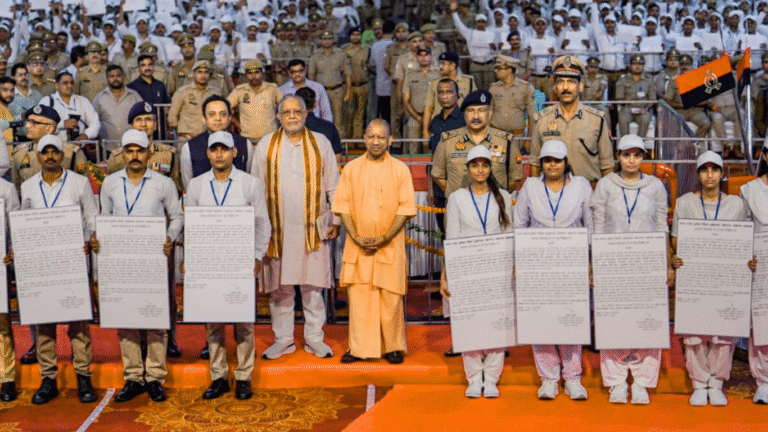
History of Kanpur: A City Built by Time and Struggle
Kanpur, located on the banks of the Ganga River, has a history that dates back to the 13th century. It is believed that the name Kanpur is derived from the word “Kanhiyapur,” linked to Lord Krishna. Over time, the city gained importance, especially during the British colonial period.
In the 19th century, Kanpur became a key center during the First War of Independence in 1857. The city witnessed fierce battles, especially at the Wheeler’s entrenchment. Nana Sahib, a prominent figure of the rebellion, led the charge against British forces here. The tragic incidents at Bibighar remain a dark chapter in British-Indian history. After the revolt, the British tightened their control, but Kanpur’s significance only grew.
By the late 1800s, Kanpur emerged as one of the leading industrial cities in India. It became home to textile mills, leather factories, and engineering firms. Because of this growth, the British called it the “Manchester of the East.” Even today, the old mills and colonial buildings remind us of its past. The city’s history is filled with both pain and pride, shaping the Kanpur we know today.
Geography of Kanpur: Along the Sacred Ganges
Kanpur lies in central Uttar Pradesh, on the southern bank of the Ganga River. Its location gives it both spiritual and geographical significance. The city is about 80 kilometers west of Lucknow and serves as an important link between eastern and western parts of the state. The flat and fertile land supports agriculture, while its river access once helped in trade and transport.
The city spreads over an area of around 300 square kilometers, with both urban and rural surroundings. The climate is typically North Indian—hot summers, a wet monsoon, and chilly winters. Summers can get extremely hot, often crossing 45°C, while winters bring cold winds, especially in January.
The Ganga River plays a big role in the life of Kanpur. Though industrial waste has affected its purity, it still holds religious importance. Various ghats, including Sarsaiya Ghat and Massacre Ghat, are places of daily rituals and historical events. The presence of green belts, canals, and parks adds a touch of nature to this otherwise industrial city.
Economy of Kanpur: Industry, Leather, and Beyond
Kanpur is often called the industrial capital of Uttar Pradesh. Its economy is driven mainly by manufacturing industries, particularly textiles and leather. The leather industry of Kanpur is world-famous, with products being exported to countries in Europe, America, and the Middle East. The city houses several leather tanneries and shoe factories, employing thousands of workers.
Textile production was once a major strength of Kanpur, with mills like Elgin Mill and Lal Imli setting the tone. While many old mills have shut down due to labor and financial issues, the legacy of textile excellence continues in smaller units. Along with leather and textiles, the city has a presence in chemical production, fertilizer, and plastic industries.
In recent times, Kanpur is slowly shifting toward service industries and education. With the presence of IIT Kanpur, the city is also becoming known for its contribution to science and innovation. However, pollution and outdated infrastructure remain challenges. The city’s economy is a mix of tradition and transition, still heavily rooted in its manufacturing spirit.
Politics in Kanpur: Voice of the Urban Middle Class
Kanpur plays a strong role in the politics of Uttar Pradesh. It has representation in both the Lok Sabha and the State Assembly. Due to its size and population, it’s seen as a politically important seat in the state. Over the years, different political parties like the BJP, Congress, and Samajwadi Party have found support here.
The city’s voters are mainly urban and educated, with a growing middle class that demands development, safety, and better civic facilities. Issues like pollution control, traffic management, clean water, and industrial regulation are key topics during elections. Local politics also sees involvement from trade unions and industrial worker associations, especially due to the strong factory base in the city.
Leadership from Kanpur has often influenced state policies, especially related to industry and employment. However, many citizens feel that despite its economic contribution, the city is often neglected when it comes to infrastructure and cleanliness. With smart city plans and metro construction underway, there’s hope for a more organized political approach in the coming years.
Demography of Kanpur: Diversity in Every Lane
Kanpur is home to over 3 million people, making it one of the largest cities in Uttar Pradesh. The population is a mix of people from various cultures, languages, and religions. Hindus form the majority, followed by Muslims, with small communities of Christians, Sikhs, and Jains. The city is truly diverse and represents the blend of modern urban life with traditional values.
Hindi is the most commonly spoken language, along with Urdu and English in formal sectors. People also use regional dialects in daily conversations. The population includes a large number of students and factory workers. The presence of educational institutions like IIT, CSJM University, and medical colleges adds a youthful energy to the city.
Kanpur’s people are known for their straightforward nature and street-smart attitude. Festivals like Diwali, Eid, Holi, and Christmas are celebrated with equal enthusiasm. The city also has a strong food culture, famous for chaats, kulfi, and tandoori dishes. Despite the crowd and dust, Kanpur’s charm lies in its people, who work hard, speak their minds, and carry a sense of pride for their city.
Conclusion: Kanpur – More Than Just a Factory Town
Kanpur may be known for its factories and leather, but it’s much more than that. It’s a city built on courage, resilience, and the dreams of everyday people. From its colonial past and freedom struggle to its present-day industrial hustle, Kanpur stands tall as a symbol of Uttar Pradesh’s spirit. With better planning and care, it has the potential to become one of India’s truly modern cities—while never losing its old-world warmth and pride.



